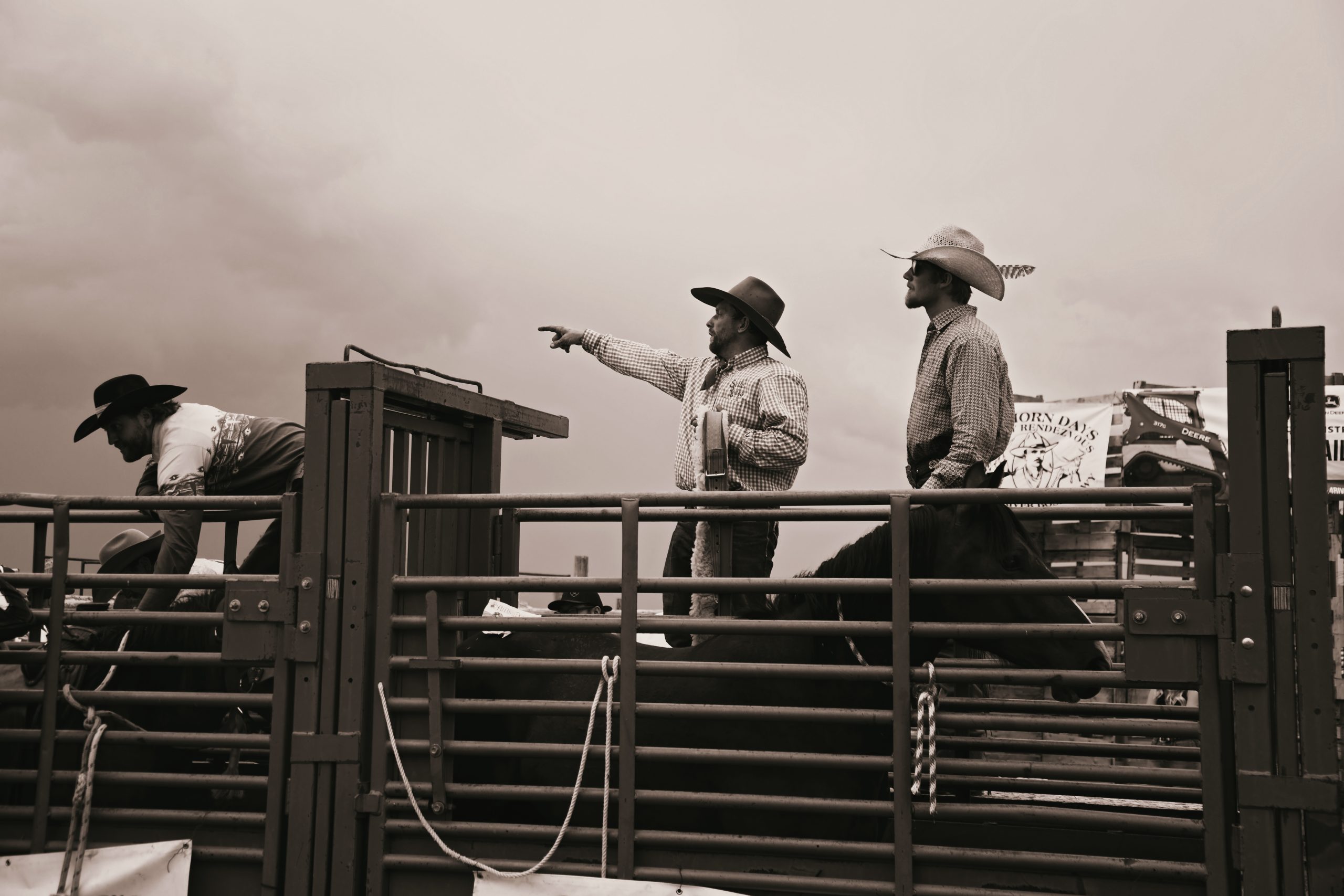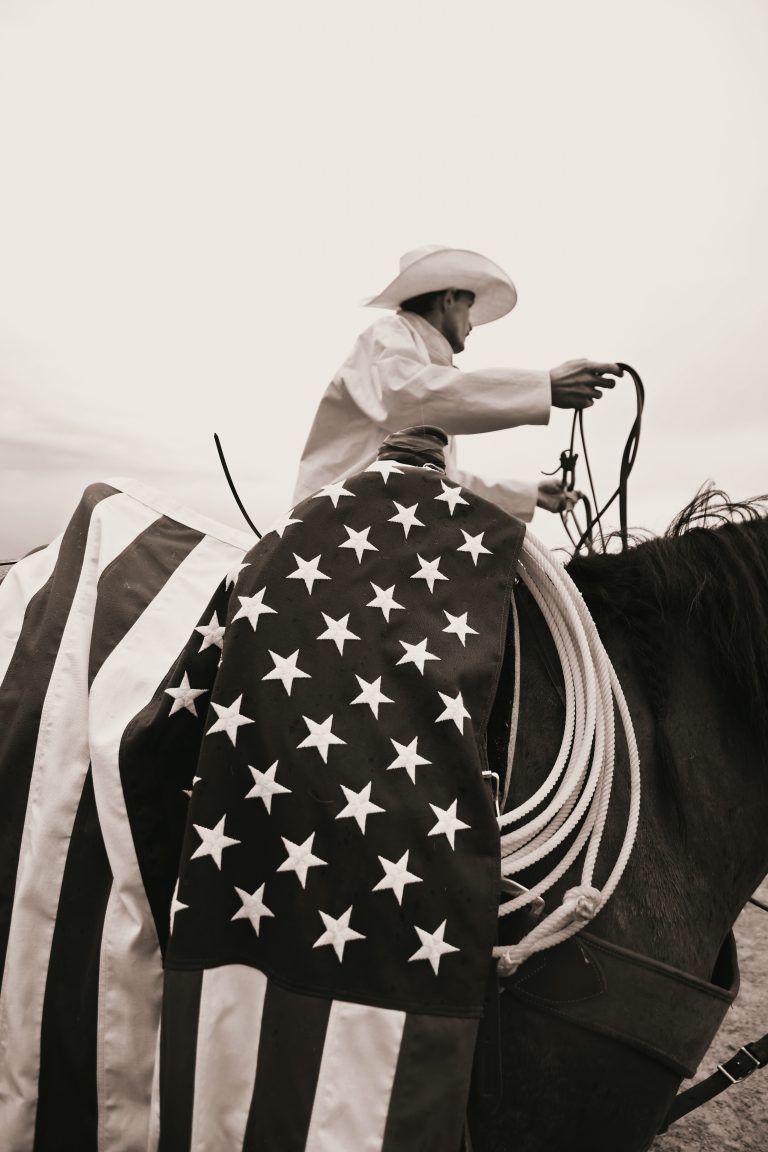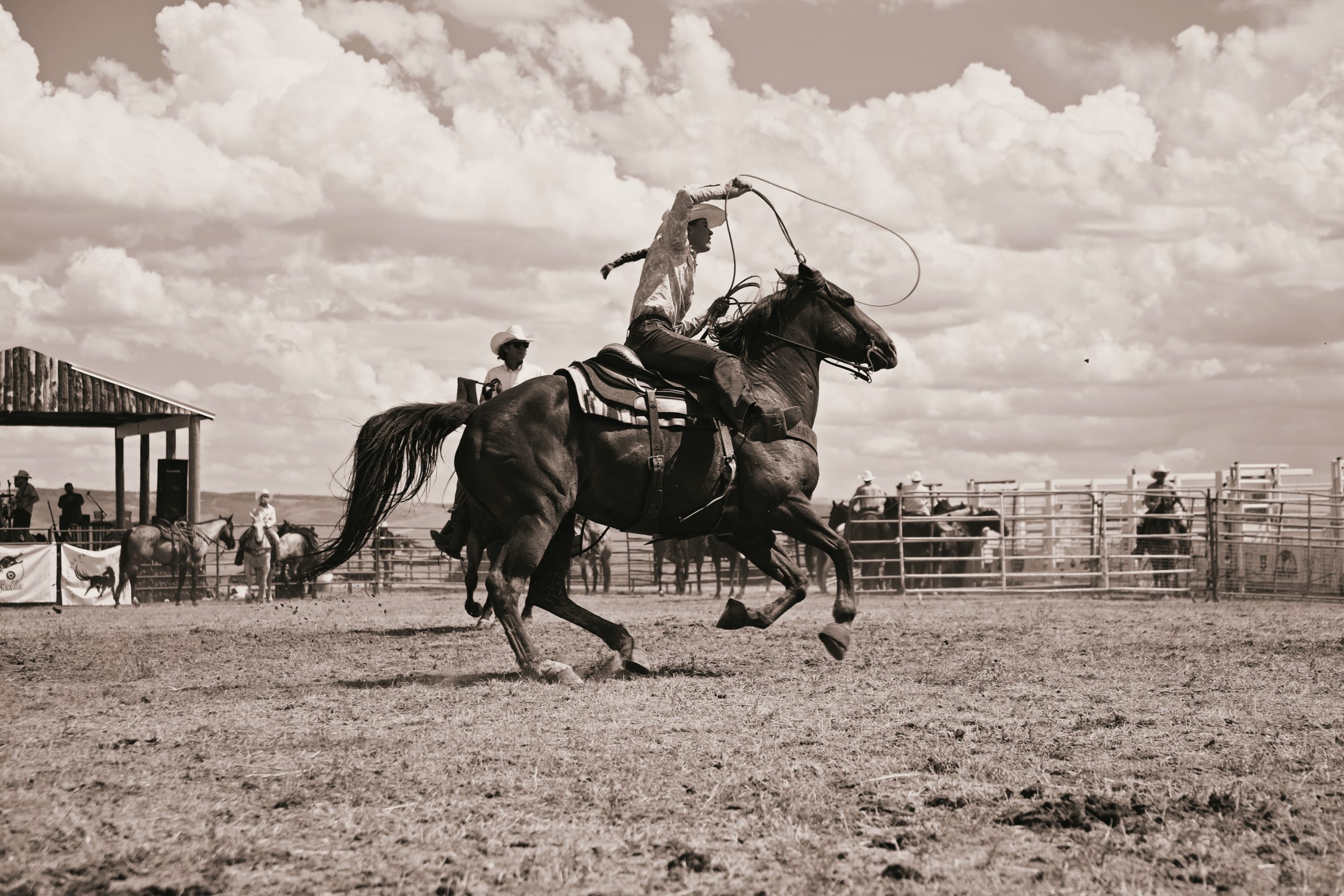We travel to Wyoming to check out a no-nonsense, no-fences rodeo celebrating cowboy legend Tom Horn.
Rand Selle got the idea during the early days of the pandemic. “It started during COVID,” he says. “After Cheyenne Frontier Days and the bigger rodeos cancelled, I didn’t think we needed to shut everything down. I figured we could social-distance by staying in our cars. The old-school rodeos didn’t have arenas, and people sat in cars to watch.”
So in July 2020, like-minded folks traveled to Bosler, Wyoming, outside of Laramie, and did just that — they made an arena out of their cars and had themselves a rodeo. This July marks the fourth annual Tom Horn Days rodeo and rendezvous in the small community along the Laramie River.
“My ranch is just 20 miles north of Laramie,” Selle says. “It’s just a little ranch in between two mountain ranges, the Sierra Madres on the left and a little range of hills between here and Cheyenne in that low spot, on the Laramie Plains.”
It’s really pretty, he says, and kind of important in the life of the rodeo’s namesake Tom Horn, the famous cowboy, soldier, range detective, and gunman who became famous — or infamous, depending — around these parts and was hung at the age of 42 in Cheyenne.
“Bosler is the town that Tom Horn got his mail from,” Selle says. Now that his rodeo keeps gaining momentum, plans are in place to move the small house Horn lived in on a nearby ranch to Bosler. “We have permission from the current ranch owner to pick up the house and move it here. It’s a log cabin-style house where Tom lived when he was at the Wallis headquarters of the Two Bar Ranch, which was originally the spread of the Wyoming-Colorado cattle baron Ora Haley; his name’s on title of the land I own. John Coble’s Iron Mountain Ranch, north of Cheyenne, was another well-known headquarters for Tom Horn; it’s now owned by the Farthing family, and the Farthings are regular contestants at Tom Horn Days every year.”
If Horn could experience the rodeo named for him, you have to think he’d feel a little proud of the three-day event and of Selle’s entrepreneurial zeal as he talks about all he’s got cooking. “Everyone comes and camps and hangs out for the weekend,” Selle says. “They start getting here Friday around noon and stay. There’s the WRCA Friday night, with a concert after. There’s team roping Saturday, ranch bronc riding in the afternoon in the pasture, then concerts in the evening. On Sunday, there’s a church service and then two ropings.”
Rodeo goes all day and music goes into the night. This year there will be four concerts. “Last year a bunch of people pitched in and helped build a full-size concert stage. This year, we’ve got Brennan Greene from Texas; Hayden Redwine, who sounds a lot like Ryan Bingham; Logan Ryan Band, and Tyler Halverson Band.”
Selle’s not the kind of guy to ignore concessions and vendors — 50 to 60 set up last year, which is pretty indicative of the momentum of attendance. Each year, the event’s gotten bigger, from 500 attendees the first year to 1,000 the second and 1,500 the third. “It’s exciting,” Selle says. “Now we’ve even got a new partner-sponsor — Ranch Life, based in Laramie, an online presence for anything you’d need on the ranch. They are sure helping a lot.”
The Tom Horn Days rodeo keeps growing, along with its reputation in the agricultural community. Selle holds true to history and finds it important. “Our little attribute in keeping the heritage alive is that we now own and brand our bucking horses with the same brand the famous bucking horse Steamboat wore.” The Lazy 20 brand — a lazy 2 over a lazy 0 — was gifted to us by Doug Kafka. He believed the brand needed to stay on a Wyoming bucking horse. So now Selle Rodeo carries on that legacy.”
Get Selle talking about Wyoming and rodeo, and the stories keep coming. “The silhouette of a cowboy and bucking horse that is so famous in Wyoming — it’s the logo for the state that’s on the license plate and for University of Wyoming — the bucking horse in the silhouette is Steamboat,” Selle says. “He was born near Chugwater, Wyoming, in 1896. He was jet black with three white socks and went on to have a famous rodeo career. The owner of that horse when he was born was Frank Foss. His brand was the Lazy 20. That horse was then sold to Coble, the owner of the Iron Mountain Ranch. Then Coble sold Steamboat to the Irwin brothers, who had a Wild West show. It also happens that the Irwin brothers sang at Tom Horn’s hanging. And it was Tom Horn’s 30-30 rifle that the Irwin brothers used to put down Steamboat at the Cheyenne Frontier Days rodeo grounds after he was cut while out west — they hauled him back on a train.” Come fall, Selle will be doing a tribute to Steamboat with a ranch rodeo and activities for college students in nearby Laramie the Thursday of homecoming before the big football game.
There’s so much intertwined history with Tom Horn, Steamboat, the big ranches, and Cheyenne Frontier Days, Selle says. And now his own Tom Horn Days is part of the mix.
The common denominator in all that gets him so enthusiastic? Selle loves the Western lifestyle and rodeo life and just about everything having to do with Wyoming — the history, the horses, the grit, and the gusto. After all the dust settles on all the hard work of any given day, Selle abides by a personal philosophy that has a distinctly cowboy outlook. “Relax,” he says, “and have a good time!”
Erika Haight
She came, she saw, she photographed.
Most of my photographic work is done on the reservation, but I am always looking to shoot rodeos or document the Western way of life. This particular event was mentioned to me while I was shooting a small ranch rodeo up in Ingomar, Montana. A couple introduced themselves to me and mentioned that I should head to Laramie for Tom Horn Days. I agreed to the event not knowing exactly how far Bosler, Wyoming, was from my hometown of Roundup, Montana. It’s approximately an eight-hour drive as the crow flies, and in the dark it feels like 14 hours.
Pulling into Bosler at night, I could see the arena lights from the highway. Come daylight the next morning, I could see all the campers and horse trailers — lots of them. I spied the huge arena, made of nothing but chairs and trucks from the spectators who had come to watch. No fence! Open country for as far as the eye could see!
The bucking stock was beautiful, healthy, and well-cared-for. The corrals were made of lodgepole pine and stood taller than I did. Just behind the arena was a newly built stage for the nightly concerts. Even before things really got rolling, it smelled like barbecue and Coors Light soaked in wet wood. Vendors made two solid rows, selling everything from silver jewelry and clothing and saddles to food and handmade rodeo toys.
There was a torrential downpour the night I arrived, and there was a small shower the next day in the late afternoon. It didn’t dampen spirits in the least. Instead, it provided some relief from the hot summer sun and knocked the dust out of the air.
Owner-operator Rand Selle was nothing if not intense. The first time I saw him, he was pulling up in a semi with a load of panels. He jumped out and unloaded them all by himself. It was impossible to snatch his attention even for a minute. Constantly running, lifting, gathering — I don’t think I ever saw his heels touch the ground. His determination and grit have made the event an obvious success.
You can hear trains running the background. “Two Rivers Road, which is the old railroad tracks, was on the line where Butch Cassidy and the Sundance Kid held up the train between Medicine Bow and Rock River, about 30 miles north of my house,” Selle said. Tom Horn is obviously not the only fascinating character in the area.
I’ve been to a lot of rodeos, and this one had a different feel from others. This felt more like a family reunion. Most people seemed to know one another. There were lots of hugs and smiles. It lacks the glitter and show of a typical rodeo, but it’s the real deal. It’s patriotic, as an American flag center mass in the middle of the arena proclaims. When it came to shooting, I realized that although I am short and generally have to shoot upward, here I was almost always shooting from ground level, and by that I mean I spent the majority of my time hiding from the summer sun, tucked under the mud flat of a Chevy truck. I got up close and personal, occasionally having to pull my legs in so I didn’t get trampled. That’s where the action is — where the dirt hits your lens and the universe comes to you.
My favorite images were the boys watching the bronc riders from atop the lodgepole fence. Their dreams, their future ... I couldn’t hear their conversation, but I have a good idea of what they were talking about. I also love the shot of two cowboys in deep contemplation, prior to their ride and the image of the woman breaking out from the box swinging her loop.
What I found to be extremely special about the event was the tribute to a young man who lost his life due to addiction. They bucked John Beer’s ashes out of the chute on the last horse he rode. The horse, W7, was renamed No More Empty Saddles. I was standing so close I breathed a little of his life into me. I don’t think there was a dry eye to be seen. What an amazing way to honor a cowboy’s memory. I learned they’ve created the suicide-awareness nonprofit No More Empty Saddles (nmemptysaddles.com), so that those who are in need always have a pickup man.
I wish I’d gotten to stay the entire time. I missed out on shooting the muley roping, stray gathering, and cowboy church on Sunday. I hope to make it back this year!
The 4th Annual Tom Horn Days will take place August 11–13 in Bosler, Wyoming. Tickets and information are available at tomhorndays.com.


























